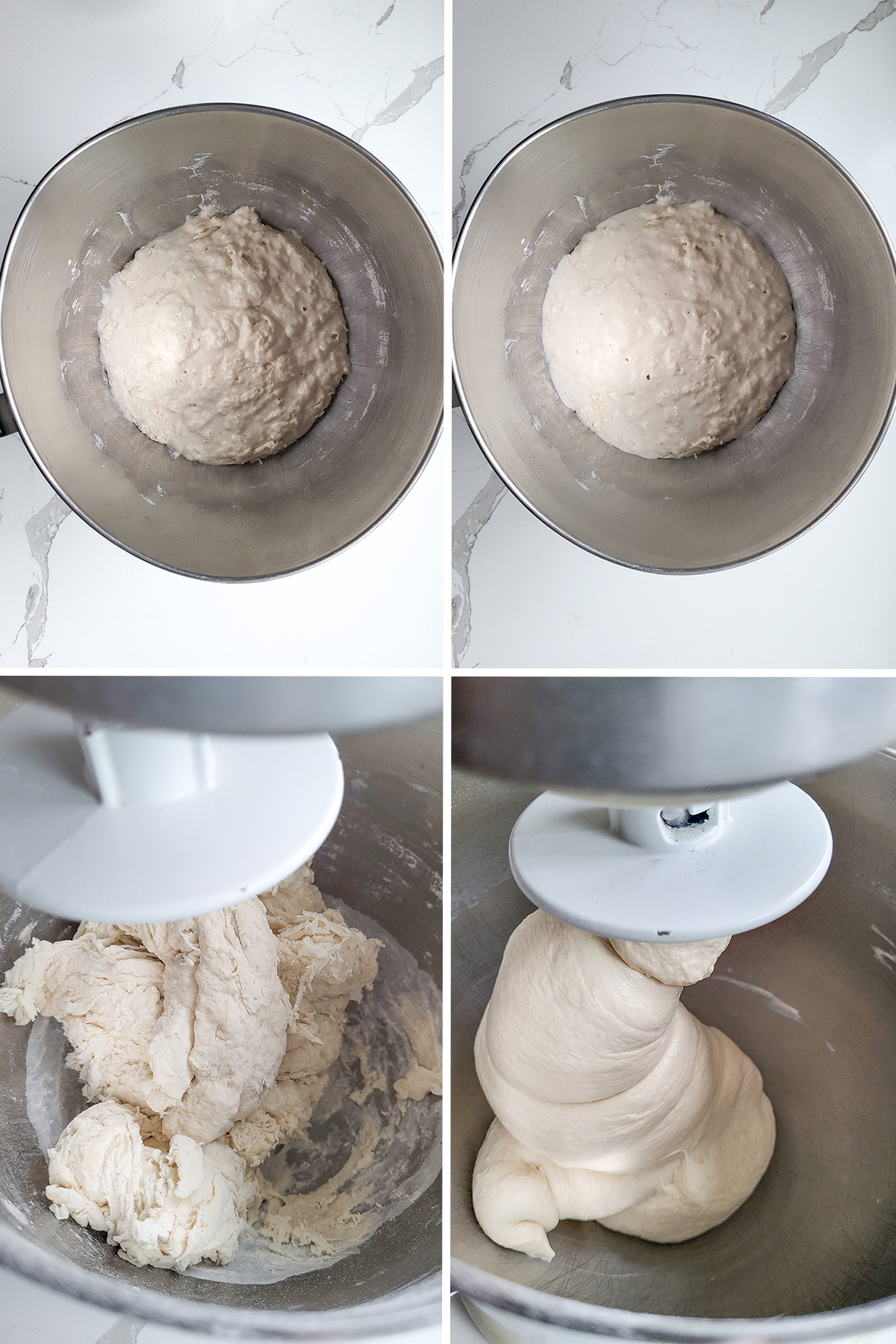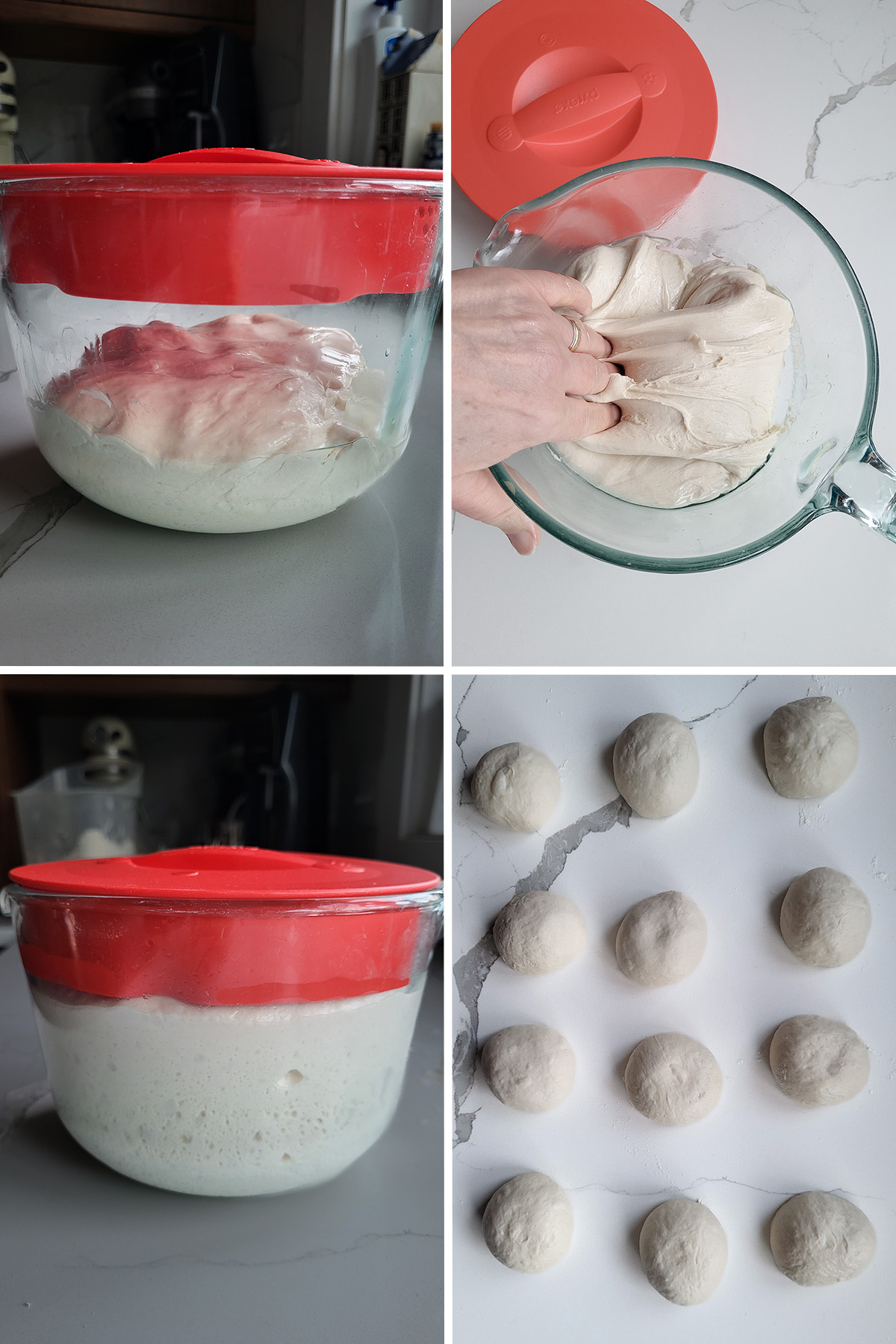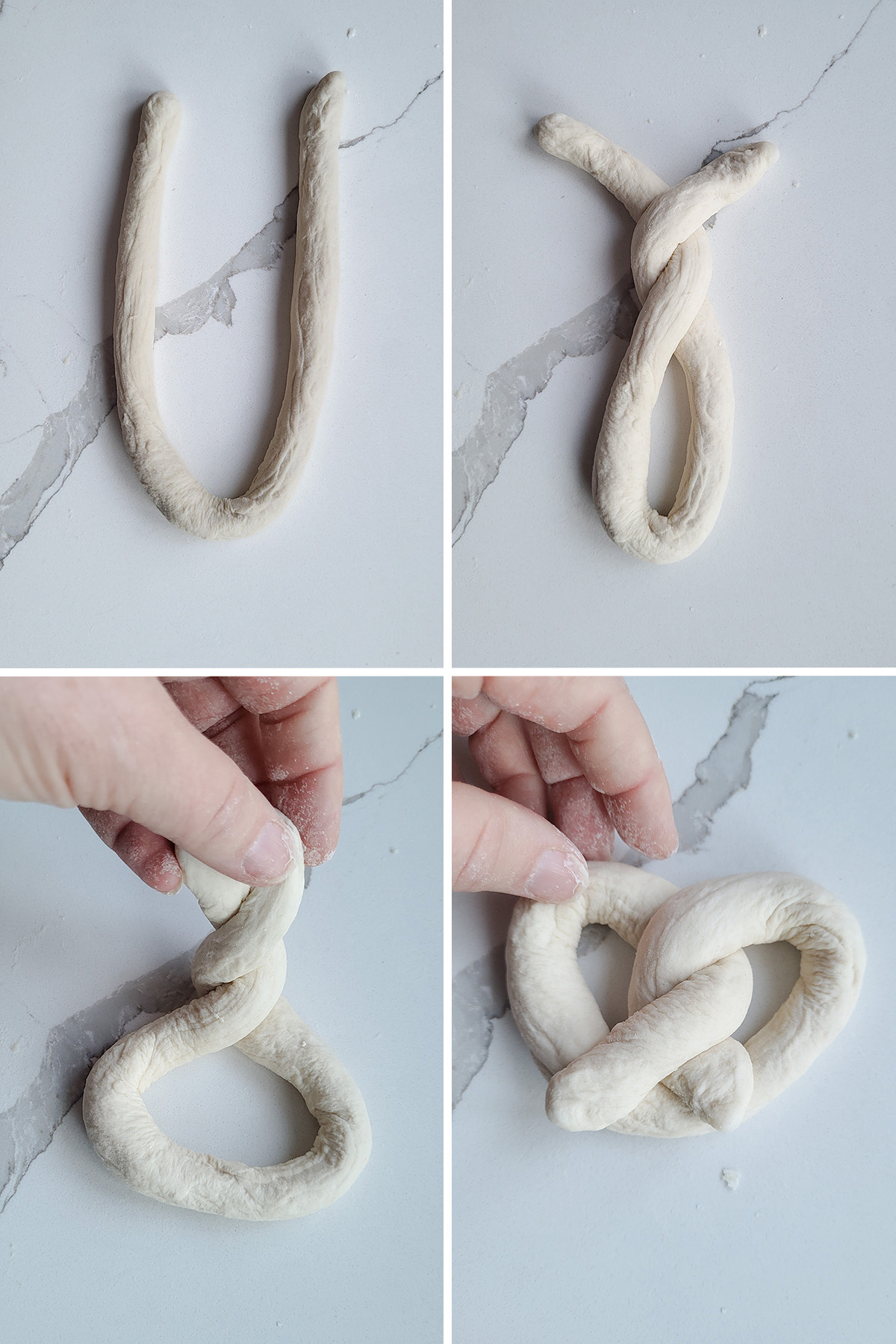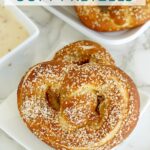Sourdough Soft Pretzels
Sourdough pretzels have a deep flavor from long fermentation and the satisfying chew and crisp crust of a classic soft pretzel. These pretzels are a fun, hands-on baking project for the whole family.

Table of contents
Why you’ll love this recipe
This recipe uses active sourdough starter for both leavening and flavor, resulting in a dough that’s complex yet easy to work with.
The process includes a quick dip in an alkaline (baking soda) bath for that signature “pretzely” crust.
I like to start the dough in the afternoon/evening of day 1 and then roll the pretzels the next morning.
If you work on this schedule you’ll have fresh hot pretzels by early afternoon. The baked pretzels freeze really well. Just pop them in the oven to re-warm before eating.
We ate these Sourdough Soft Pretzels with my Jalapeño Cheddar Dip, only this time instead of a fresh jalapeño I made the sauce with chopped up Pickled Jalapeños. YUMMMMMY!
If you don’t have one, check out my post to learn How to Make a Sourdough Starter. Then check out my system to Feed and Maintain Sourdough Starter or you can learn How to Keep a Small Sourdough Starter.
I know you hate to throw away that sourdough discard. Check out these recipes that use sourdough discard.
Ingredients

Ingredient Notes
- All Purpose Flour – Medium content AP flour makes a pretzel with a soft crumb but with enough elasticity to shape into the iconic pretzel twist.
- Sourdough Starter – The recipe was developed using a 100% hydration starter. If your starter is not 100% hydration you will need to adjust the flour or water in the recipe as needed.
- Baking Soda – The baking soda bath is alkaline (not acidic). The alkaline bath gives the pretzel the classic slightly bitter crust. The alkaline bath also aides in browning so the pretzels become deeply golden brown in the oven.
Process Photos
See the recipe card for detailed measurements and instructions.

- Combine the active starter with water and some of the flour. Set it aside for 1 hour. This give the flour time to absorb the water and begins the process of gluten development.
- Add the sugar, salt and remaining flour to the sponge.
- The dough will start out quite shaggy.
- After 5 minutes of kneading the dough should be cohesive, cling to the hook and clear the sides of the mixing bowl.

- Set the dough aside at room temperature for the initial fermentation.
- Every hour fold the dough over itself to aerate the dough and redistribute the yeast.
- After a night in the refrigerator the dough is ready for shaping.
- Divide the dough into 12 equal pieces and roll each piece into a tight ball.

- Roll the dough to a long rope. Pull up the two ends to form a “U”.
- Twist the ends 2x.
- Lift the twisted end toward the center of the “U”.
- Lift the pretzel by the top to transfer to the baking sheet. Set the pretzels aside for 1 hour.

- Boil the pretzels in the baking soda bath for 10 seconds per side.
- Transfer the boiled pretzels to a cooling rack to drain. Continue with the rest of the pretzels.
- Transfer the boiled pretzels to the baking sheet. Brush with egg white and sprinkle with salt.
- Bake until golden brown.
Storage
The pretzels are best warm from the oven or within a few hours of baking. Pack left over pretzels into storage bags and freeze up to a month. Re-warm the pretzels in a low oven to serve.
More Pretzel Recipes
More Sourdough Recipes

If you love this recipe as much as I do, I’d really appreciate a star rating and a quick comment. Ratings and comments help my recipes show in search results. Thanks!
Sourdough Soft Pretzels
Video
Ingredients
- 8 oz active sourdough starter (1 cup, 100% hydration)
- 10 oz warm water (1 ¼ cups)
- 17 ½ oz all-purpose flour (3 ½ cups, see note)
- 1 tablespoon granulated sugar
- 1 ½ teaspoons table salt
- 2 quarts water
- 2 ½ oz baking soda (⅓ cup, for boiling)
- 1 egg white (lightly whisked)
- salt and seeds for garnish
Instructions
- Combine 8 oz active sourdough starter and 10 oz warm water in the bowl of a stand a mixer with the paddle attached (or mix by hand).
- With the mixer running on low add 10 oz (2cups) of the flour and mix to form a smooth batter. Cover the bowl and set it aside for 30-60 minutes.
- Switch to the dough hook and add 1 tablespoon granulated sugar, 1 ½ teaspoons table salt and the remaining 7 ½ oz flour. Knead on medium speed for 5 minutes. The dough will clear the bowl and cling to the hook after kneading. If mixing by hand knead the dough hand for 5 minutes, sprinkle with extra flour as you knead if required.
- Scrape the dough into a lightly oiled bowl, turning once to coat. Cover the bowl and set aside at room temperature.
- After 30 minutes uncover the bowl, lift one side of the dough and fold it into the middle of the dough. Repeat with the other three sides of the dough then flip the dough over. You're basically turning the dough inside-out to redistribute the yeast. Cover the bowl and after 60 minutes repeat the procedure again.
- Cover the bowl and after 60 minutes turn the dough one more time. By now the dough should be lively, elastic and airy. If the dough is still sluggish give it another hour or two at room temperature. Cover tightly and refrigerate overnight.
Make the Pretzels (Day 2)
- Remove the dough from the refrigerator. Line 2 baking sheets with parchment paper and sprinkle the paper lightly with flour.
- Turn the cold dough out onto a floured surface and divide into 12 equal pieces and roll each piece into a smooth ball. Shape a dough ball into a rope. Using flat hands, roll the dough back and forth moving your hands in opposite directions from the middle of the rope towards either end. If the dough gets sticky dip your hands in flour and continue. The dough should stick to the surface just a little so that the friction will allow you to pull the dough into a long rope. The longer and thinner the rope the more open the pretzel shape will be. Try to get the rope to about 20"-24"
- To form a pretzel lift the dough rope on either end and allow the middle to sit on the surface, forming a "U" shape. Twist the ends of the rope together 2x and fold the twist over and rest on the center of the "U". Lift the pretzel by the two top loops and place on the baking sheet.
- Cover the tray with plastic wrap and set aside to for 1 hour to bring the dough to room temperature.
- Meanwhile, combine 2 quarts water and 2 ½ oz baking soda in a large pot and bring it to a boil. Preheat the oven to 475 °F.
- Drop the pretzels into the boiling water for 10 seconds, flip and boil another 10 seconds. (I can fit about 3 at a time in my pot, don't overcrowd the pan). Set the boiled pretzels onto a cooling rack set over a clean baking sheet. Continue boiling all the pretzels.
- Transfer the pretzels back to the baking sheets. Brush each pretzel with egg white and sprinkle with coarse salt and/or seeds of your choice. Bake until puffed and golden brown, about 15 minutes. Turn the sheets halfway through baking so they brown evenly.
- They’re best eaten warm from the oven. They also freeze really well.
Would you like to save this recipe?
As an Amazon Associate and member of other affiliate programs, I earn from qualifying purchases.










Can I simply double this recipe? I’ve made them several times, but I’m wondering if any adjustments are needed in doubling.
yes, you can double the recipe. To have enough starter you may need to do an extra feeding without discarding.
I’ve been making Alton Brown’s soft pretzel recipe for a few years now and we love them. I’d like to try your sourdough ones but I live at 7200 ft and know that the altitude can mess up sourdough baking. Do you have any suggestions about doing this recipe at high altitude?
Sorry, I don’t have any experience with high altitude baking. Can anyone else help?
@Eileen Gray, the main thing for me at altitude I’ve found is the effect on the hydration of the dough. I find the hydration needs to be a little higher for the same result, but its best to experiment with smaller percentage increases and work your way up. But I am trying your recipe now and kept the hydration as is. The dough is a little firmer than I am used to, but it came off the sides of the bowl and onto the dough hook as described so I’m holding thumbs for a good result!:)
Thanks for the insights, Kieren!
@Wendy,
I’m at high altitude also and whenever I bake with sourdough,as I’m putting the dough in the oven, I toss about a cup of water in the oven to steam/humidify it.
Works perfectly.
I have been using 120 grams as the metric weight for flour for all of my recipes since I started baking bread a little over a year ago. I think it is so much easier to weigh ingredients instead of measuring and I don’t have to wash the measuring cups! I see that you use 140 grams as the metric weight for flour, so I am not sure which weight to use when making your sourdough pretzels. I use King Arthur flour and they use the 120 grams. I am wondering if I should start with the 120g and then if the dough looks too wet, just add more flour. Any suggestions?
Hi Nina. You are right that weighing ingredients is easier and more accurate than using cups. That being said, the weight of a cup of flour is not an absolute. It depends on how the person doing the measuring fills the cup. I use the “dip and sweep” method to fill the cup. That is, I dip the cup into the flour bin, overfill it, then sweep away the excess flour. Using this method I consistently get 5 oz per cup (140g) for ap and bread flour. If you spoon the flour into the cup you’re likely incorporating more air and the cup of flour will weigh less. Different bakers use different methods. Always follow the recipe weights as written since the recipe writer will have tested the recipe using their own method for measuring the flour.
@Eileen Gray, Thanks. I appreciate your quick reply. I was actually in the process of making a batch when I posted the question so I went ahead and started with the smaller amount but ended up with about what your recipe called for (140g). I didn’t actually measure what I added. The dough was so lovely and when I took it out of the refrigerator in the morning it was full of bubbles. The pretzels got rave reviews from my husband and I agree. I will definitely make this recipe again and just start with the 140g.
I just recently found your website and I have really enjoyed your recipes. I also love the details of your instructions and all of your information about sourdough. There is a lot of information out there about sourdough and over the year and a half that I have been working with it I have read a lot of confusing and conflicting information. Yours has been very helpful. Thank you so much for sharing your knowledge with all of us!
Am I wrong in thinking that this recipe uses sourdough discard?
“Active” sourdough starter means a starter that has been fed and is ready to use. Discard is what you have before you feed the starter.
@Eileen Gray, unfortunately, this and many other recipes on the internet claim in the description
to use to sourdough discard, only to find the actual recipe uses the starter.
@Diane, the header description in the recipe says “they’re made with sourdough starter” and the recipes lists “active sourdough starter”. So I’m honestly not sure where the confusion is coming from.
@Diane, where did she mention using discard? The recipe clearly says the starter is used.
@Todd, the website that I came from was and claims this recipe uses discard.
While I appreciate that Foodprint shared my recipe, it is confusing that they say it’s a discard recipe. You could use discard, but of course you’d have to feed it first to make it active enough for the recipe.
@Diane,
I found this recipe by stumbling upon an article that showed 20 ways to use a sourdough discard instead of wasting it. I ended up just using my discard and they turned out wonderful with no issues with rising.
What kind of seeds do you recommend using?
Anything that you like. I often use just coarse salt, but I’ve also used an “everything bagel” mix.